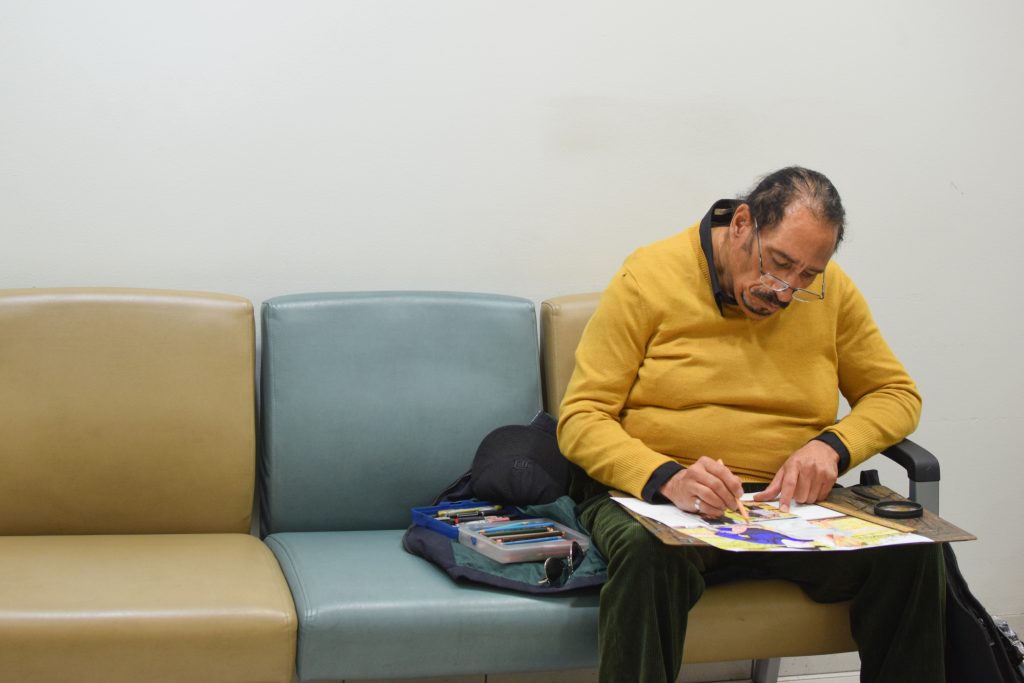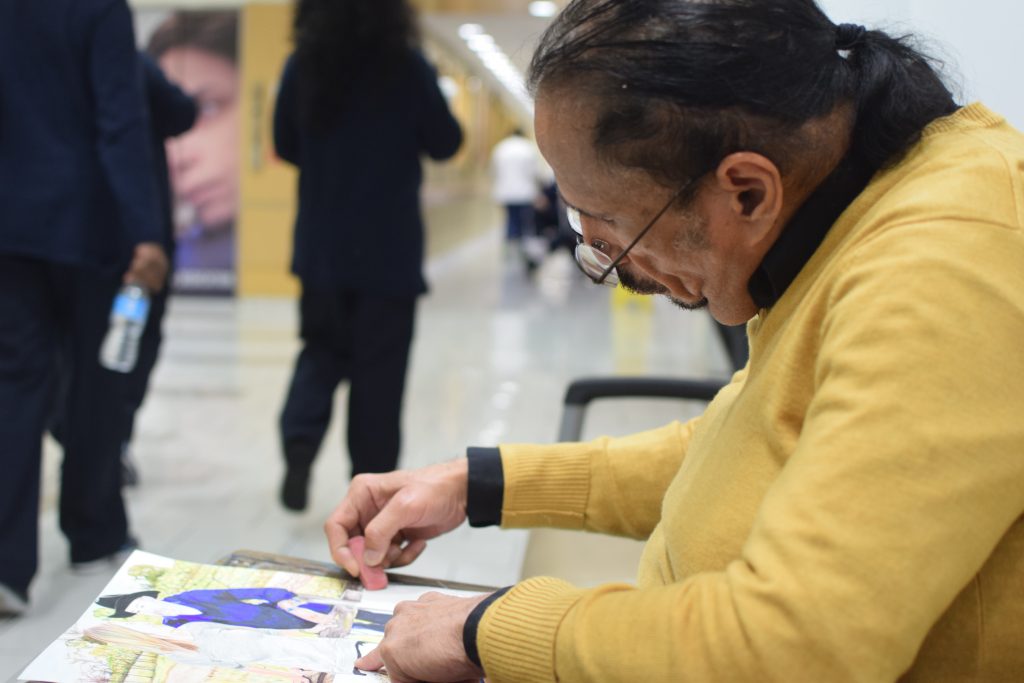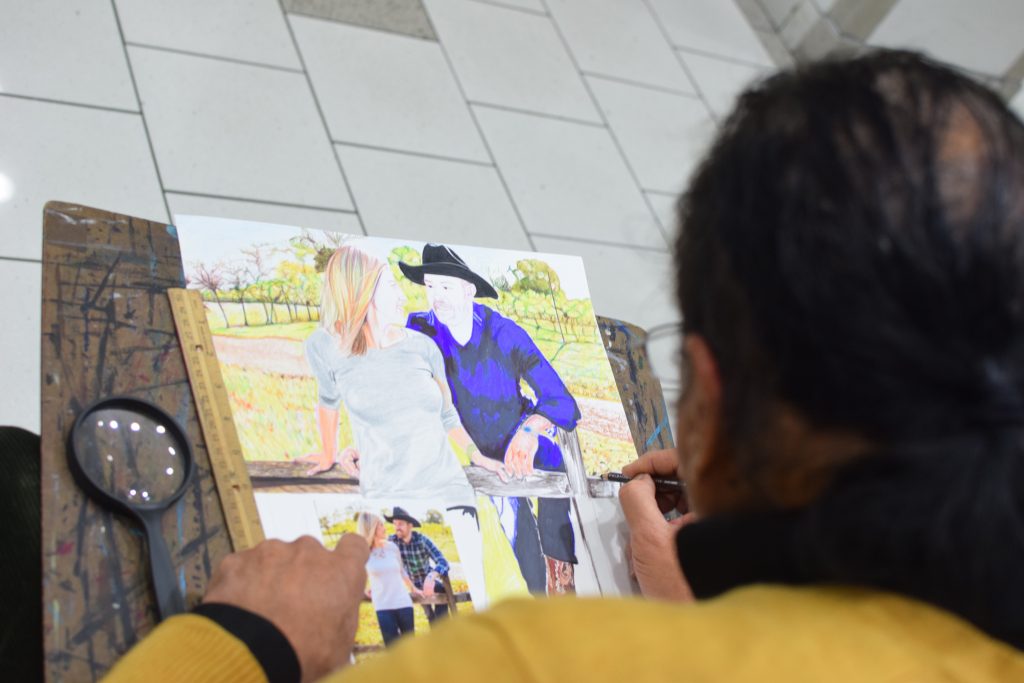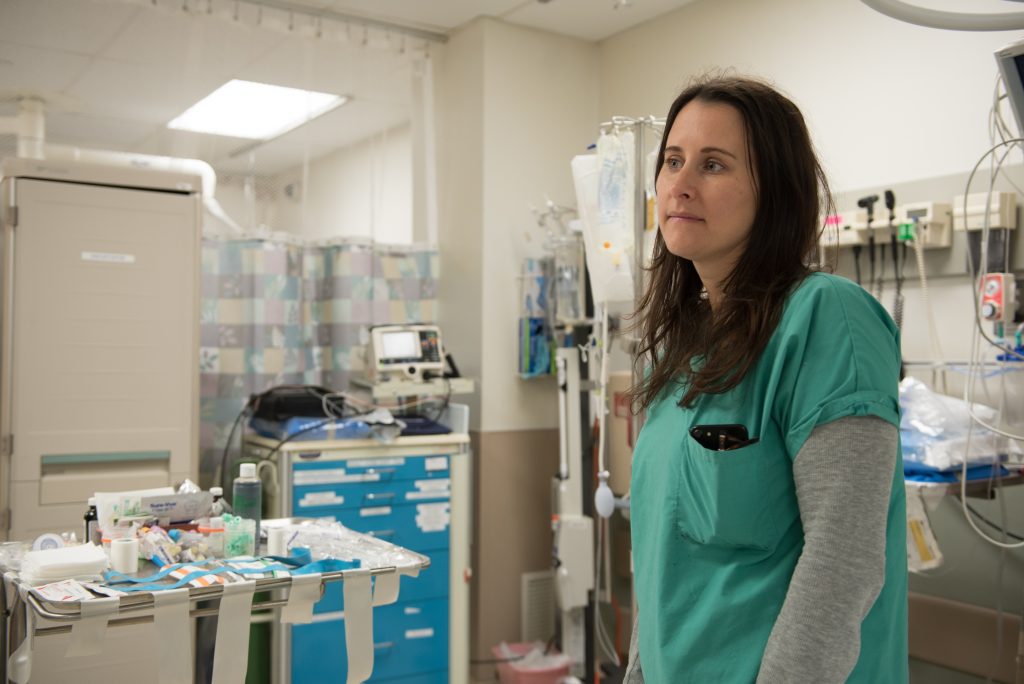Michael Vitez carries a quote from author William Faulkner’s 1950 acceptance speech for the Nobel Prize in Literature in his wallet. It reads, “[Man] will prevail…because he has a soul, a spirit capable of compassion and sacrifice and endurance. The poet’s, the writer’s duty is to write about these things.”
“Good stories build community, help people heal,” said Vitez, the director of narrative medicine at the Lewis Katz School of Medicine. “[It’s] cathartic for people to share their story. … They can change the world.”
Vitez joined the school’s faculty in April. He writes stories about patients at Temple University Hospital and helps students and physicians reflect on the demand of the medical field through writing.
Narrative medicine is one of several initiatives medical students and professionals are integrating into their practices to make them more personable physicians.
Along with Vitez’s arrival at the school, six new electives were offered that tapped into the humanities through mediums including art, photography and cooking.
NARRATIVE MEDICINE

Michael Vitez sits in the lobby of the Lewis Katz School of Medicine. He left the Inquirer after 30 years to join Temple's faculty in April. BRIANNA SPAUSE | PHOTO EDITOR
During his 30-year career at the Inquirer, during which he earned a Pulitzer Prize, Vitez bred a passion for writing human interest stories. Vitez said leaving the Inquirer after a buyout was “the hardest decision [he] ever made.” But his love of storytelling persists.
In his new role, Vitez said he has tried to create a “storytelling culture” at TUH to emphasize that patients are more than their ailments.
“There are incredible stories in every room of the hospital,” Vitez said. “There’s incredible compassion and heroism and dedication and sorrow and all these great human emotions. … I think that people don’t stop and celebrate that. They’re very clinical.”
Vitez found one of his stories sitting on a padded bench in the Tioga Lobby of TUH next to a box of worn-down markers, colored pencils and erasers. Jonathan Thomas was the subject of “The Artist in the Lobby,” a story Vitez published in August for the school of medicine on Medium — a website for writers and editors to share and create content.
Thomas started drawing in the lobby every weekday about 15 years ago. He told his doctors in the ophthalmology ward, which specializes in eye disorders, that he was an artist, and they asked to see his work. Since then, he has drawn pictures of patients, nurses, doctors, their family members and pets ― all based off photographs.



Jonathan Thomas began drawing in Tioga Lobby of Temple University Hospital about 15 years ago. GRACE SHALLOW | THE TEMPLE NEWS
Thomas, who is blind in his left eye, uses a magnifying glass to help him as he works. He said his “fascination with the pencil” began when he was 7 years old and his father gave him a Batman comic book.
Thomas said he has few close relationships with family and friends — he calls himself “a stray to a bunch of wolves” in the world. He finds solace in drawing and interacting with people at the hospital.
“I found out that there are people who really care,” he said. “The hospital is supposed to be a caring place with a bunch of caring people, not a place where people stereotype. Evil begins evil and good begins good. It spreads. It’s contagious.”
Dr. Naomi Rosenberg, an emergency room doctor at TUH and a professor of medicine, published an essay, “How to Tell a Mother Her Child Is Dead,” in the New York Times in September. Vitez encouraged Rosenberg to send it to the publication.



Dr. Naomi Rosenberg has worked at Temple University Hospital since 2013. This August, her essay "How to Tell a Mother Her Child Is Dead" was published in the New York Times. BRIANNA SPAUSE | PHOTO EDITOR
The essay outlined Rosenberg’s experience as a doctor helping family members dealing with the aftermath of trauma. She wrote the piece at a writing festival in Iowa this summer after presented with the prompt, “Tell someone how to do something you know how to do.”
Rosenberg heard a response from the newspaper in 42 minutes, and the piece was the “most viewed” article on its website on Sept. 5, Vitez said.
But online popularity was never the motivation for Rosenberg’s story.
“Writing has always been one of the great tools that we have to think about and express where we live or the places that we care about,” Rosenberg said. “I think we can’t ever underestimate the importance of using our voice to talk about the things that we see and are happening.”
In the emergency room, Rosenberg said she is exposed to the “themes of humanity,” like life, death and change. She added that the patients in an emergency room don’t start their days knowing they will be patients, and doctors never know who will check in.
“Medicine is a discipline and a field made up of human stories,” she added. “The humanities have shown us for a long time how to tell stories, how to listen to a story and how to pick up on things that are relevant and important details in people’s stories.”
HUMANITIES IN THE CLASSROOM
When Dr. Douglas Reifler meets patients, he asks questions about their educational backgrounds, where they come from and what their families are like ― characteristics that “make a person a person,” he said.
“In my case, humanities are applied in every interaction I have with my patients,” said Reifler, the associate dean of student affairs at the medical school and a physician at TUH.
This semester, the concept was manifested in medical students’ curricula through six electives: An Exploration of Narrative Medicine, Humans of North Philly, Exploration of Meaning Through Stories, Reflections on Gross Anatomy, Artful Thinking and My Daughter’s Kitchen.
Reifler said all of the electives shared one goal: making students better physicians by tapping into the emotion of the medical field. Sensitivity helps students better understand patients and themselves, he said.
“Learning and practicing medicine are both very stressful,” he said. “If you feel like stress has some purpose and you’re accomplishing something by going through it, you’re much more likely to be satisfied with it and adapt well to it. … If not, it’s easy to get demoralized, depressed, burnt out.”
Reifler said Dr. Larry Kaiser, the dean of the school, hired him in August 2015, and assigned him the task of developing a curriculum to form students’ “professional identities.” Implementing the humanities was a natural choice, Reifler said.
In Human Gross Anatomy, one of the first classes taken as a medical student at Temple, students unzip a body bag, take out a cadaver — a corpse used for medical study — and make dissections. Reifler taught Reflections on Gross Anatomy, which allowed students to reflect on their experiences in the class through writing and reading.
“It’s designed to help them … underscore their empathy for their cadaver and think about the life and the history of the cadaver, while at the same time recognizing that their task is dissection,” he said. “They need to be able to do both if they’re going to be successful as a physician in the long run.”
Scott Shore, the associate dean of graduate and special programs in the medical school, taught Artful Thinking this semester at the Philadelphia Museum of Art. Medical students examined paintings from several genres and discussed what they saw by writing what they thought a figure in the painting was thinking or a question they had about the piece.
Shore also piloted Art in Medicine: Observation and Drawing, a drawing class taught in the Tyler School of Art and offered to “Career Changers” ― participants in the program who are interested in a career in medicine, but have not taken the science courses required for admission to medical school.
Gauging the students’ skills of observation — a characteristic necessary as a physician — was a goal in both courses, Shore said. He added that he intended the drawing class to foster an appreciation for the human body among students before they were face-to-face with a cadaver during Human Gross Anatomy.
“The beauty of medicine is that it has a huge science component and a huge medicine component,” Shore said. “Many students find that [the humanities are] a wonderful distraction from having to learn all that heavy duty science that they do every day and use the other side of their brain.”
Maureen Fitzgerald, the food editor at the Inquirer, taught the elective My Daughter’s Kitchen, in which five medical students learn how to cook healthy meals to serve six people with ingredients that cost no more than $20.
The elective is an extension of the My Daughter’s Kitchen program at Vetri Community Partnership, a Philadelphia nonprofit that encourages healthy eating. With the help of 70 volunteers, Fitzgerald teaches young kids in 35 schools across the region the same basic cooking skills she teaches her medical students.
“Cooking is such a lost art for all aspects of society,” Fitzgerald said. “It’s everywhere. People’s lives are so busy and people have just lost the skill.”
“These medical students have to be able to talk to their patients about healthy eating,” Fitzgerald added. “If they don’t know how to cook [for] themselves and how to feed themselves, they’re going to have a hard time talking to patients about doing it.”
The elective My Daughter's Kitchen was taught by Maureen Fitzgerald, the food editor at the Inquirer, and met eight times this semester. GRACE SHALLOW | THE TEMPLE NEWS
Hilario Yankey, a second-year medical student, said chopping vegetables was a therapeutic escape from his classwork every week. He said he’ll apply the things he learned outside the classroom to eat healthier, especially with his favorite recipe — fish tacos with baked sweet potato fries.
“It is true that if you don’t have a lot of time you go for a burger or something that is not healthy, but she’s teaching us a lot of things that are very quick, but at the same time, very healthy,” he added. “Sometimes you need to be doing something, but not doing what you are used to.”
The Health Sciences Campus is just making room for medical humanities, but Reifler has been interested in the concept since he was an undergraduate. He studied biochemistry and English at Harvard University during the late 1970s.
“A lot of my own satisfaction comes from feeling like I had very effective tools to help medical students go through medical school in constructive ways and come out wiser, more aware of themselves and better-adjusted,” Reifler said.
THE PATIENTS THEY SERVE
When TUH opened, there were 20 beds for patients in a three-story house on Broad Street near Ontario Avenue. On January 18, 1892, Russell Conwell re-named the building the Samaritan Hospital and proclaimed it would serve people no matter their financial status, race or religion.
Next year will mark the 125th year that the hospital has served the community. According to its website, TUH now houses 722 beds and had more than 200,000 outpatient visits during 2015.
According to the hospital’s 2016 Community Health Needs Assessment, the hospital is also located in a federally designated “medically underserved area,” defined by the Health Resources and Services Administration as an urban area where “residents have a shortage of personal health services.”
“There are incredible stories in every room of the hospital. There’s incredible compassion and heroism and dedication and sorrow and all these great human emotions. … I think that people don’t stop and celebrate that. They’re very clinical.” Michael Vitez, Director of Narrative Medicine
The assessment also said two-thirds of the families in the hospital’s service area live in poverty, which is higher than the overall poverty rate of Philadelphia. More than 80 percent of inpatients receive Medicare or Medicaid.
“I feel like [narrative medicine] is a great opportunity to try to somehow improve life here, improve care by writing about this world,” Vitez said. “People feel a real special mission to serve this community.”
Rosenberg said doctors can relate to every patient based on emotion — an experience that is shared among people of different races, religions, genders and financial statuses.
“You’re involved with people at a time in their life where something’s happening to them, oftentimes bad, that they won’t ever forget,” she added. “All of us have the experience of being scared, not knowing what’s happening to us or not knowing what’s happening to someone that we love.”
Thomas, TUH’s weekday lobby artist, lives on Erie Avenue and is a former patient. He said there is a divide between “the worlds of patients and doctors.” Reifler said connecting students with nearby residents is often difficult and vice versa.
Thomas added that he thinks focusing on medical humanities is a wonderful solution to bridge the gap by teaching tolerance.
“You have to be patient with a patient,” Thomas said. “That’s why they’re called patients.”
“The doctors need to know what’s wrong with a person, what’s on their mind,” he added. “A lot of people keep stuff in. They gotta let it out. … That’s what health care is about.”
Grace Shallow can be reached at grace.shallow@temple.edu or on Twitter @grace_shallow.
Photos by Brianna Spause and Grace Shallow.
Video by Abbie Lee.
Graphics by Finnian Saylor, Courtney Redmon and Sasha Lasakow.
Produced and designed by Donna Fanelle and Joe Brandt.